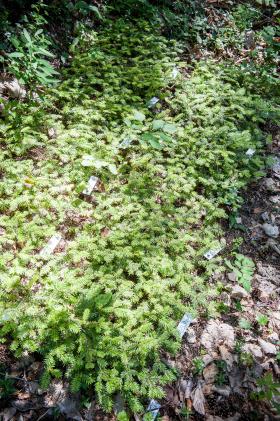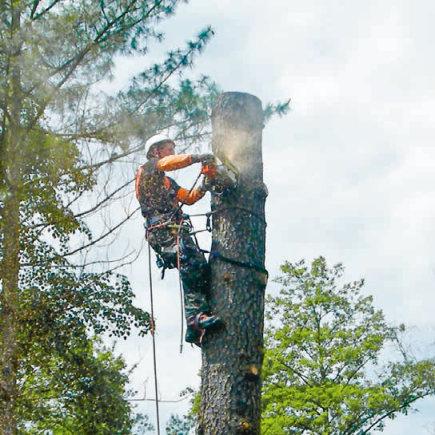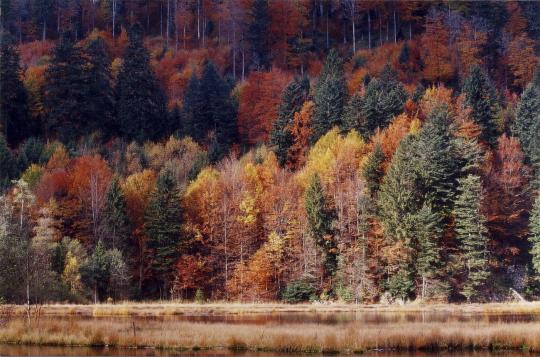Ressources dossier
Climate change and risksAdaptation: ideas for action
Published on 09 December 2022
Mixing species
Mixed forests and plantations are a popular approach to a diverse range of risks and their co-occurrence. But does mixing species guarantee a good outcome
While mixed forests and plantations are proven to be more resilient on average to insect, fungal and other pest attacks, the results for climate risks are less conclusive. Scientists have observed that while these forests fare better against strong winds, mixing does not always help with drought. Nevertheless, multi-species forests and plantations —ideally those that are mutually beneficial on an ecological level, via different root development or water demand in periods of foliation or flowering, and compatible in terms of forestry management— are the best choice. Potential consequences for biodiversity and ecosystem services must also be considered. Surprisingly, certain animal or plant species that thrive in pure stands (containing only one tree species) are absent from mixed forests, for example 1. It is therefore necessary to diversify management with a combination of pure, mixed and unmanaged forests.
Preferable associations
In mixed forests, the number of species present is less important than composition in determining resilience. From this point of view, associations of deciduous and coniferous trees are particularly interesting. Tests are underway, in the OPTMix system in the Val de Loire region and ORPHEE in Nouvelle Aquitaine, with observations in pure and mixed stands of several species of interest 2 for the sector. The studies examine the effects of climate, forest management mixes and densities and large herbivorous animals on the functioning of mixed forests.
At the European level, FunDivEurope, a consortium of 29 institutes, including INRAE, evaluated the environmental services provided by more than 200 forests in 6 countries with different climates: Finland, Poland, Germany, Romania, Italy and Spain. The findings leave no room for doubt: more species-diverse forests provide more services, including water purification and soil preservation. Similar studies are ongoing worldwide until 2024 on almost 1.2 million trees in 26 more or less intensively mixed forests as part of the MixForChange project. For the last 2 years, the I-Mastro project has been evaluating how diversification promotes a forest’s resilience to climate change in four countries in Europe: Poland, Slovenia, Germany and France. The findings of this study were published in December 2022.
1. Korboulewsky N. et al. 2016. How tree diversity affects soil fauna diversity: a review. Soil Biology and Biochemistry, 94: 94-106..
2. OPTMix: sessile oak and Scots pine/ ORPHEE: birch, Pyrenees oak, common oak, holm oak, maritime pine
Genetic diversity
Genetically, two neighbouring trees in the same forest are on average ten times more diverse than two human beings separated by thousands of kilometres and millennia. This remarkable genetic diversity, found in most forest tree species, is in some ways the “fuel” of the evolution “driven” by natural selection.
Researchers have shown that genetic diversity within a single tree population can vary as much as that between trees in very different locations. The dynamics of this diversity, enriched generation to generation by mutations and the mixing of genetic information via reproduction, take long periods of time. Climate change, on the other hand, which occurs in the space of a single generation, raises the issue of whether the ‘survival insurance’ offered by genetic diversity is sustainable in the long term. Foresters can rely on genetic diversity to adjust forest renewal practices and create new varieties with high adaptation potential or interest for the bioeconomy.

It is therefore essential to conserve and even enrich this limited capital, to manage it well by establishing ‘adaptative’ forest management practices, and even restore it when it has been degraded. Coordinated by INRAE, the European GenTree project (H2020, 2016-2020, 22 partners) has made it possible to better understand genetic diversity among 12 native species found across Europe and of interest to the sector, including maritime and Scots pine, common spruce, sessile oak and beech. An analysis of data obtained on 4,750 trees in over 200 natural forests identified forests for which genetic diversity must be conserved and how to go about it. This is valuable help for the development of European strategies for biodiversity and forests by 2030.
In addition, the European B4EST project (H2020 2018-2022, 19 partners) studies the genetic basis of the response of trees to climate, the interest of genetic diversity in breeding and the diversification of the variety offer to anticipate tomorrow's needs for 8 economically important species
Assisted migration
Accelerate natural migration by promoting or planting trees that are better adapted to future soil and climate conditions

Foresters and researchers apply this strategy to get ahead of the game. The idea is to accompany the migration of tree species or provenances1 beyond their current range to an (often) more northerly or higher location, where the results of climate projections at the end of several decades anticipate the conditions of their current niche.
The importance of an entire ecosystem
Primarily designed as a way for forests to adapt to drought and heat waves, this technique involves assessing forest ecosystem evolution in all its complexity: the biodiversity that it shelters and which must be preserved, and the soil or the environmental, economic or social services that it provides. Assisted migration is already applied in the field and is under assessment. Approximately 30% of the trees planted by the ONF in the Grand Est region of France in the winter of 2021-2022 fall under this category.
Species under study
For the past four years, foresters have received special authorisation to test replacements of certain species in difficulty in the North-East by more southern cousins.
PThis is the case, for example, of downy oak and maritime pine, which could gradually replace sessile oak and Scots pine. Among the recent flagship projects in which INRAE is a partner, REN-Essences (coordinated by the ONF) and Esperense (RMT AFORCE coordination) aim to identify and test new, lesser-known species or origins, such as Turkish pine and Hungarian oak from Bulgaria, that are both resilient, productive and able to provide comparable ecosystem services in different regions exposed to climate change. The first candidate species should be identified within 5 to 8 years. In the long term, these first “islands of the future” may be the only seed resources for these candidate species, some of which are in poor condition today in their natural area.
1. Provenance determines the geographical origin of a tree species. It is an area characterised by ecological conditions to which trees have adapted and developed similar genetic characteristics (source: ONF).
Keeping forestry one step ahead
Forest management is driven by how tree populations evolve, from the renewal phase to harvesting, which takes between 50 and 200 years depending on the species. The older the forests are, the greater the potential is for environmental and economic impacts from risks, particularly weather.
Another solution is forest rejuvenation and a faster generational renewal.
Thinning has proven effective in most of the world’s forests for almost all species, to mediate the impact of soil drought, limit dieback and kickstart growth after drought. Fewer trees per hectare means less leaf area, less evapotranspiration, less interception of rainfall and less competition. Another solution is forest rejuvenation and a faster generational renewal. Young trees resist drought better, but are more vulnerable to fire (due to their thinner bark and lower crown height) and frost. They also have a better chance of adapting to the current climate, morphologically and anatomically speaking, than older trees. Reducing rotation —the number of years before the final harvest— makes it possible to shorten the length of time during which vulnerable older trees are exposed to climatic hazards. Continuous or accelerated regeneration also promotes the faster selection of genes best adapted to the changing climate.
Interventions: getting it right

Naturally, these silvicultural solutions, designed to improve resilience in production forests, must be tailored to combine provisioning and supporting services, applying intervention methods to preserve soil quality and keep old trees and dead wood in forests to conserve biodiversity, for example. Other forestry solutions should be applied in forests where environmental issues such as carbon storage or biodiversity are of primary importance, such as reserves, historic forest areas that pre-date 1850, and unmanaged ‘senescence islands’. In these protected areas, intervention should be a last resort to conserve woodland or plant species on which endangered animal species depend.
Ensuring success

The climessences.fr website, a multi-partner endeavour of RMT AFORCE, compiles data from 10 years of research to assist in the selection of forest species in a changing climate. Since 2021, it has been used to analyse the level of risk involved in establishing nearly 150 European species (110 evergreens, 37 deciduous species) in France based on two climate scenarios for 2100: one optimistic, with global warming of 2 degrees celsius, and the other pessimistic, with warming of 4 to 5 degrees.These resources can be a source of ideas at the compartment level for owners and managers, and at the forest or regional level for public authorities.
In parallel, INRAE, AgroParisTech and the ONF launched the RENFOR innovation cluster in 2017 to support foresters facing challenges in renewing their forests, either by natural regeneration or planting. The unit designs silvicultural renewal programmes and evaluates their economic, environmental and social performance. It proposes methods to limit initial mortality of trees in plantations, often due to summer droughts, and to reduce eagle fern invasion in naturally regenerating compartments. It also develops planting tools to make the work of foresters easier, and cultivation processes that reduce damage caused by ungulates. Last but not least, IN-SYLVA-France, a national infrastructure coordinated by INRAE, operates over 4,000 ha of forest for experimentation in forest management and coordinates the resources of forest management research organisations. Experiments at several sites combine forestry, biogeochemical and genetic solutions to promote a comprehensive vision of forestry and develop adaptive and sustainable management.
-
Sarah-Louise Filleux & Catherine Foucaud-Scheunemann
Authors / Translated by Emma Morton
